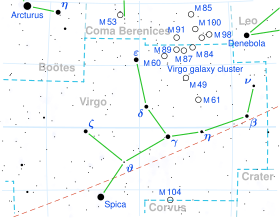astro.wikisort.org - Star
Omega Virginis (ω Vir, ω Virginis) is a solitary[2] star in the zodiac constellation Virgo. It has an apparent visual magnitude of +5.22,[2] which is bright enough to be faintly visible to the naked eye. Based upon an annual stellar parallax shift of 6.56 milliarcseconds,[1] it is located about 500 light years from the Sun.
 | |
| Observation data Epoch J2000 Equinox J2000 | |
|---|---|
| Constellation | Virgo |
| Right ascension | 11h 38m 27.60727s[1] |
| Declination | +08° 08′ 03.4663″[1] |
| Apparent magnitude (V) | +5.22[2] |
| Characteristics | |
| Spectral type | M4 III[2] |
| U−B color index | +1.63[3] |
| B−V color index | +1.60[3] |
| Astrometry | |
| Radial velocity (Rv) | +5.13±0.52[4] km/s |
| Proper motion (μ) | RA: −3.89[1] mas/yr Dec.: +5.30[1] mas/yr |
| Parallax (π) | 6.56 ± 0.36 mas[1] |
| Distance | 500 ± 30 ly (152 ± 8 pc) |
| Absolute magnitude (MV) | +0.2[5] |
| Details | |
| Radius | 70[6] R☉ |
| Luminosity | 1,515[7] L☉ |
| Surface gravity (log g) | 0.8[5] cgs |
| Temperature | 3,490[7] K |
| Metallicity [Fe/H] | −0.08[5] dex |
| Other designations | |
| Database references | |
| SIMBAD | data |
This is a red giant star with a stellar classification of M4 III.[2] It is a semiregular variable with a brightness that varies over an amplitude of 0.m28 with periods of 30 and 275 days.[9] After evolving away from the main sequence it has expanded to around 70 times the solar radius,[6] and now shines with 1,515 times the luminosity of the Sun.[7] The effective temperature of the outer atmosphere is 3,490 K.[7]
References
- van Leeuwen, F. (November 2007), "Validation of the new Hipparcos reduction", Astronomy and Astrophysics, 474 (2): 653–664, arXiv:0708.1752, Bibcode:2007A&A...474..653V, doi:10.1051/0004-6361:20078357, S2CID 18759600.
- Eggleton, P. P.; Tokovinin, A. A. (September 2008), "A catalogue of multiplicity among bright stellar systems", Monthly Notices of the Royal Astronomical Society, 389 (2): 869–879, arXiv:0806.2878, Bibcode:2008MNRAS.389..869E, doi:10.1111/j.1365-2966.2008.13596.x, S2CID 14878976.
- Mermilliod, J.-C. (1986), "Compilation of Eggen's UBV data, transformed to UBV (unpublished)", Catalogue of Eggen's UBV Data, SIMBAD, Bibcode:1986EgUBV........0M.
- Famaey, B.; et al. (2009). "Spectroscopic binaries among Hipparcos M giants,. I. Data, orbits, and intrinsic variations". Astronomy and Astrophysics. 498 (2): 627–640. arXiv:0901.0934. Bibcode:2009A&A...498..627F. doi:10.1051/0004-6361/200810698. S2CID 18739721.
- Smith, V.V.; Lambert, D.L. (1986), "The chemical composition of red giants. II - Helium burning and the s-process in the MS and S stars", Astrophysical Journal, 311: 843–863, Bibcode:1986ApJ...311..843S, doi:10.1086/164823
- Pasinetti Fracassini, L. E.; et al. (February 2001), "Catalogue of Apparent Diameters and Absolute Radii of Stars (CADARS) - Third edition - Comments and statistics", Astronomy and Astrophysics, 367 (2): 521–524, arXiv:astro-ph/0012289, Bibcode:2001A&A...367..521P, doi:10.1051/0004-6361:20000451, S2CID 425754.
- McDonald, I.; et al. (2012), "Fundamental Parameters and Infrared Excesses of Hipparcos Stars", Monthly Notices of the Royal Astronomical Society, 427 (1): 343–57, arXiv:1208.2037, Bibcode:2012MNRAS.427..343M, doi:10.1111/j.1365-2966.2012.21873.x, S2CID 118665352.
- "* ome Vir". SIMBAD. Centre de données astronomiques de Strasbourg. Retrieved 2016-09-19.
{{cite web}}: CS1 maint: postscript (link) - Glass, I. S.; Van Leeuwen, F. (2007), "Semiregular variables in the solar neighbourhood", Monthly Notices of the Royal Astronomical Society, 378 (4): 1543–1549, arXiv:0704.3150, Bibcode:2007MNRAS.378.1543G, doi:10.1111/j.1365-2966.2007.11903.x, S2CID 14332208.
На других языках
- [en] Omega Virginis
[es] Omega Virginis
Omega Virginis (ω Vir / 1 Virginis / HD 101153)[1] es una estrella en la constelación de Virgo de magnitud aparente +5,24. Se encuentra a 496 años luz del Sistema Solar.[2]Текст в блоке "Читать" взят с сайта "Википедия" и доступен по лицензии Creative Commons Attribution-ShareAlike; в отдельных случаях могут действовать дополнительные условия.
Другой контент может иметь иную лицензию. Перед использованием материалов сайта WikiSort.org внимательно изучите правила лицензирования конкретных элементов наполнения сайта.
Другой контент может иметь иную лицензию. Перед использованием материалов сайта WikiSort.org внимательно изучите правила лицензирования конкретных элементов наполнения сайта.
2019-2025
WikiSort.org - проект по пересортировке и дополнению контента Википедии
WikiSort.org - проект по пересортировке и дополнению контента Википедии